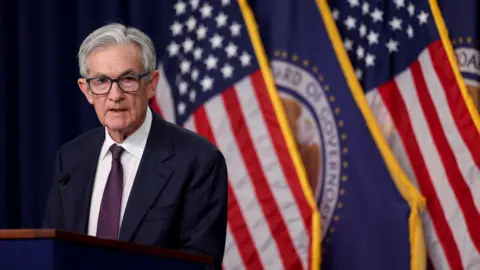Fed holds interest rates for fourth time despite tariff turmoil
 Bloomberg/Getty
Bloomberg/GettyPeople and businesses in the US have faced a whirlwind of policy change in recent months. But one thing has remained fixed: borrowing costs set by the US central bank.
The Federal Reserve stuck with that strategy on Wednesday, leaving its key interest rate unchanged, even as officials' expectations for the economy worsened.
The decision marked the fourth in a row without action, keeping the bank's influential lending rate hovering around 4.3%, where it has stood since December.
That came despite forecasts from policymakers suggesting they expect slower growth, higher unemployment and faster inflation than they did just a few months ago.
Typically, the Fed lowers borrowing costs if it believes the economy is struggling and raises them if prices start to rise too quickly.
President Donald Trump has repeatedly called on the Fed to cut interest rates, while pushing major changes to economic policy, including raising tariffs on goods from around the world.
Fed officials, who are empowered to set interest rates independent of the White House, have said they are worried that a one-time jump in prices due to those new levies could morph into a more persistent problem.
Inflation, the pace of price increases, remains above the Fed's 2% target, coming in at 2.4% in May.
Federal Reserve chairman Jerome Powell said the bank was braced for prices to rise more quickly in the months ahead as firms start to pass on the cost of the import taxes to their customers.
"That process is very hard to predict," he said, noting that it would depend on how big the tariffs are and their duration.
"That is why we think the appropriate thing to do is hold where we are."
He said the bank could afford to wait, noting that the economy overall remained "solid" and the unemployment rate remains low at 4.2%.
But projections released by the Fed showed that policymakers, on average, are expecting growth to slow to 1.4% this year, down from 2.5% last year and the 1.7% they were forecasting in March.
The forecasts call for inflation of roughly 3%, up from the 2.7% predicted in March and a rise in the unemployment rate to 4.5%.
The outlook for interest rate cuts in 2025 did not change significantly, with a majority of members still expecting rates to drop just below 4% by the end of the year.
But the projections anticipate slightly higher rates in 2026 and 2027 than previously forecasted.
In remarks on Wednesday ahead of the Fed's decision, Trump repeated his criticism of Powell, calling him "stupid" and "too late" to act, while speculating about the end of his term.
The European Central Bank has cut interest rates eight times since last June. The Bank of England cut borrowing costs last month but is expected to hold rates steady this week.
But Isaac Stell, investment manager at Wealth Club, said Trump may have "talked himself into a bit of a bind", as the Fed stays committed to its wait-and-see approach.
"Central bankers tend to jealously guard their independence, which means that unless there's a really compelling reason to cut they might just stay sat on the fence," he said.
Fed interest rate decisions determine what it charges banks for short-term loans.
That rate in turn has significant influence over borrowing costs across the economy, informing what regular banks end up charging households and businesses for mortgages and other kinds of loans.
At 4.3%, the Fed's benchmark interest rate remains markedly higher than it was between 2008 and 2022, when the bank started to hike rates in response to rising prices.
But it is roughly a percentage point lower than where it stood last year.
